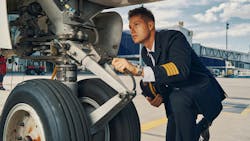Over the years, I have made probably 30 10-day long fishing trips to Canada with family and friends. Each trip always comes with much preparation and excitement. For most of us, planning for our vacations is usually half the fun of the trip. After so many of these trips, I pretty much know what equipment, clothes and supplies to take. The trouble is, if I forget just one crucial item, it could ruin my week, as we go to very remote locations and I can’t just hop in the truck and run to town. The way I prevented forgetting anything was by creating a list of items to take. These items ranged from a passport, plenty of socks, fishing tackle, or how about even a black marker and tape to label the fish we bring home? “What does the even have to do with collision repair?” you ask. Please keep reading.
In the past year, I have flown on a commercial airplane several times. Has everything gone just perfectly each time? Well, no, but I always arrived at my desired destination and most importantly, safely. From 1968 to 1977, airplane passenger boardings resulted in 1 fatality out of every 350,000. From 2008 to 2017, the numbers improved to 1 in every 7,900,000. Even better yet, in 2018 to 2022 it’s 1 in every 13,700,000. Obviously, air travel has become much safer over the years. Otherwise, air travel since 2022 has become 39 times safer than back in 1968. FYI: Currently, we are 48 times more likely to get injured in a car accident than on a commercial airplane.
Obviously, technology has helped improve air safety, but there is also another seemingly small but crucial underlying factor. For most folks who have flown in an airplane with a window seat, you have probably observed the pilot outside walking around the airplane. If you are anything like me, I have asked myself, “What all is he/she even looking at?” Well, the pilot is inspecting the nose cone, landing gear, wings, flaps, engines, tail section for any damage, and more. Most commercial city hopper planes are flown multiple times per day and therefore have visual inspections multiple times per day. These inspections seem very redundant, along with a waste of time and money, right?? Ha-ha well, whether it be you or me on that next flight, that airplane had better have been inspected before taking off, EVERYTIME!!!!
Before pilots take off in an airplane, they are following a preflight check, which includes an exterior visual inspection. In layman’s terms, it’s a “checklist.” Similarly, in hospitals before the first incision is made on a patient undergoing a surgery, a surgical safety checklist is to be followed.
It might include things like:
A. Have all team members introduce themselves by name and role.
B. Does the patient have any allergies?
C. Is it the right or left leg?
D. Has an antibiotic been administered?
E. What is the anticipated blood loss?
F. Do we have ample blood available?
Whether we are piloting an airplane with 350 souls on board, performing an open-heart surgery on a patient, or repairing a vehicle that has been involved in a collision, following a checklist is crucial.
As collision repairers, we are ultimately responsible for the safety of the passengers in every vehicle we repair. Not only are we responsible for the SRS components and structural integrity of the vehicle after pulling/welding, but have we done the basic checks of door and hood latches or that the lug nuts were tightened?!
By following checklists, we can prevent safety issues for every vehicle that leaves our shops. But we can even improve profitability by lowering our costs.
Every day in nearly every shop across the country, at least one vehicle in the build department must stop for some type of problem. Either we missed a broken part, missed damage, received a left foglamp instead of a right, a new mirror cap wasn’t painted, etc. These costs are nearly incalculable.
Many problems can be fixed just by following a simple checklist. You can very easily create your own and they can even be by departments.
Here are just a few examples of a car entering the body department:
A. Pull car and parts into correct bay.
B. Review estimate and repair procedures.
C. Complete measuring & pulling if required.
D. Complete all mechanical work etc.
E. Take photos of all body work etc.
You get my point here. Checklists are applicable to every department and crucial to preventing firefighting & chaos. FYI: 80% of all plane crashes are from pilot error!! This is no different for collision shops and employee errors.
Here is a great book on this subject that I would highly recommend: “The Checklist Manifesto How to get things right,” by Dr. Atul Gawande.
